Minerals/Chalcogens
< Minerals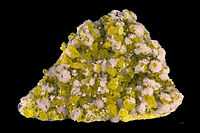
The chalcogens are the elements of group 16 of the Periodic Table. These include oxygen (O), sulfur (S), selenium (Se), tellurium (Te), polonium (Po), and livermorium (Lv).
Chalcogen minerals are those with a high atomic percent of chalcogens.
Oxygens
Native oxygen does not exist as a mineral on the surface of the Earth.
Oxygen-based minerals are those minerals with more than 25 at % oxygen. Oxygen often combines with most of the other elements in the periodic table.
Oxidanes
These are minerals composed of or more than 25 at % H2O.
Abernathyites
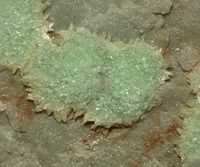
Abernathyite has the chemical formula KUO2AsO4·3H2O.[1] There are three oxygen groups in this mineral:
- UO2,
- AsO4, and
- 3H2O.
Each of these form mineral groups:
- uraninites, 16.7 at %,
- arsenates, 27.8 at %, and
- oxidanes, 50.0 at %, with the atomic percentages included.
On these bases, abernathyite is both an arsenate (27.8 at %) and an oxidane (50.0 at %). It is also an oxygenide at 50.0 at % oxygen. In terms of oxides, abernathyite is about 60.0 molecular percent H2O. While potassium does not occur on the surface of the Earth as native potassium, in abernathyite, the atom of potassium links to oxygens from all three oxides.
Hydroxides
Hydroxide minerals contain more than 25 at % OH.
Aeschynites
Aeschynite has the chemical formula (Ce, Ca, Fe, Th)(Ti, Nb)2(O, OH)6.[1]
Here there are two oxygen groups:
- O, oxygenides, from 11.1 to 55.6 at % likely, and
- OH, hydroxides, from 55.6 to 11.1 at % likely.
Silicates
Silicates contain more than 25 at % silicates.
Afwillites
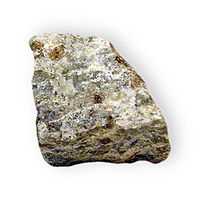
Afwillite has had a couple of formulas:
Structurally, afwillite is a nesosilicate with isolated SiO4 tetrahedra.
Afwillite has two oxides:
- 2SiO4, Silicates, and
- 2H2O, oxidanes, with each having about 50 molecular %.
Calcium does not occur as native calcium. Here it links to the oxygens in the silicate tetrahedra and the oxidanes. Afwillite is 47.6 at % silicate and 28.6 at % oxidane.
Carbonates
Carbonates contain more than 25 at % CO3.
Calcites
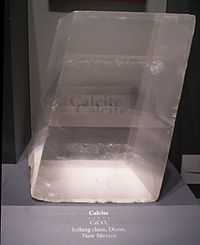
Calcite has the chemical formula CaCO3.[1]
Calcite contains one oxide: CO3, or carbonate. It is just less than 100 molecular % carbonate and 80 at % carbonate.
Sulfurs
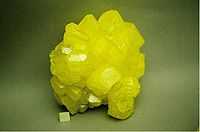
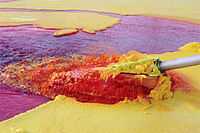
Native sulfur occurs on the surface of the Earth.
At volcanic locations, native liquid sulfur can be seen flowing, such as in the image on the right, and it is red.
Seleniums
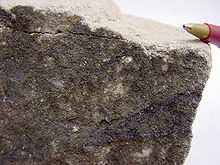

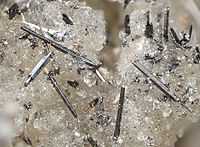
On the right is a photograph of native selenium from the mineral collection of Brigham Young University Department of Geology, Provo, Utah.
The second image down on the right shows dark gray selenium in sandstone from Westwater Canyon Section 23 Mine Grants, New Mexico.
In the magnified image of the sample on the left are native selenium needles.
Telluriums
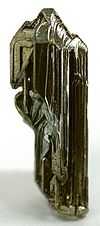
On the right is an example of native tellurium from the Emperor Mine, Vatukoula, Tavua Gold Field, Viti Levu, Fiji.
On the left is an encrustation of native tellurium on the upper left portion of a rock.
Poloniums
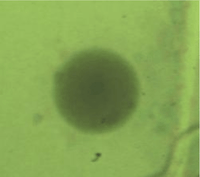


α-Po crystallizes in a simple cubic lattice.[3]
Native polonium may occur in minerals like pitchblende due to the decay of uranium. But, when the uranium is chemically bound, the polonium is likely to be also.
β-Po has a rhombohedral (trigonal) crystal structure.[4]
"Solid diorite and gabbro rock, which had previously crystallized from magma, has been subjected to repeated cataclasis and recrystallization. This has happened without melting; and the cataclasis provided openings for the introduction of uranium-bearing fluids and for the modification of these rocks to granite by silication and cation deletion."[5]
"In uranium ore-fields the extra uranium provides an abundant source of inert radon gas; and it is this gas that diffuses in ambient fluids so that incipient biotite and fluorite crystallization is exposed to it. Radon (222Rn) decays and Po isotopes nucleate in the rapidly growing biotite (and fluorite) crystals whence they are positioned to produce the Po halos."[5]
On the lower right is a photograph showing radioactive decay halos along a crack in biotite.
On the left is an example of groundwater incursion that has moved through a nearby fault. The groundwater has picked up dissolved uranium compounds and moved downward through adjacent porous sandstones. Uraninite then precipitated around a tongue of groundwater, resulting in the roll front seen in the image on the left.
Livermoriums
Although generated by heavy ion bombardment, the short-lived radioisotopes are not known to occur naturally on the surface of the Earth.
Research
Hypothesis:
- Chalcogens such as the poloniums can occur as native polonium due to diffusion of radon gas with subsequent radioactive decay to polonium without chemical combination.
- The polonium atoms adhere to fracture surfaces and decay to produce Po halos.
Control groups

The findings demonstrate a statistically systematic change from the status quo or the control group.
“In the design of experiments, treatments [or special properties or characteristics] are applied to [or observed in] experimental units in the treatment group(s).[6] In comparative experiments, members of the complementary group, the control group, receive either no treatment or a standard treatment.[7]"[8]
Proof of concept
Def. a “short and/or incomplete realization of a certain method or idea to demonstrate its feasibility"[9] is called a proof of concept.
Def. evidence that demonstrates that a concept is possible is called proof of concept.
The proof-of-concept structure consists of
- background,
- procedures,
- findings, and
- interpretation.[10]
See also
References
- 1 2 3 4 Willard Lincoln Roberts, George Robert Rapp, Jr., and Julius Weber (1974). Encyclopedia of Minerals. 450 West 33rd Street, New York, New York 10001 USA: Van Nostrand Reinhold Company. pp. 693. ISBN 0-442-26820-3.
- ↑ Hudson Institute of Mineralogy (31 October 2015). "Afwillite". Hudson Institute of Mineralogy. Retrieved 2015-11-05.
- ↑ CST (20 November 2000). "The Simple Cubic Lattice". Washington, DC USA: The Naval Research Laboratory. Retrieved 2015-08-27.
- ↑ CSTPo (20 November 2000). "The A_i (beta Po) Structure". Washington, DC USA: The Naval Research Laboratory. Retrieved 2015-08-27.
- 1 2 Lorence G. Collins (3 February 1997). "Polonium Halos and Myrmekite in Pegmatite and Granite". Northridge, California USA: California State University, Northridge. Retrieved 2015-08-27.
- ↑ Klaus Hinkelmann, Oscar Kempthorne (2008). Design and Analysis of Experiments, Volume I: Introduction to Experimental Design (2nd ed.). Wiley. ISBN 978-0-471-72756-9. http://books.google.com/?id=T3wWj2kVYZgC&printsec=frontcover.
- ↑ R. A. Bailey (2008). Design of comparative experiments. Cambridge University Press. ISBN 978-0-521-68357-9. http://www.cambridge.org/uk/catalogue/catalogue.asp?isbn=9780521683579.
- ↑ "Treatment and control groups, In: Wikipedia". San Francisco, California: Wikimedia Foundation, Inc. May 18, 2012. Retrieved 2012-05-31.
- ↑ "proof of concept, In: Wiktionary". San Francisco, California: Wikimedia Foundation, Inc. November 10, 2012. Retrieved 2013-01-13.
- ↑ Ginger Lehrman and Ian B Hogue, Sarah Palmer, Cheryl Jennings, Celsa A Spina, Ann Wiegand, Alan L Landay, Robert W Coombs, Douglas D Richman, John W Mellors, John M Coffin, Ronald J Bosch, David M Margolis (August 13, 2005). "Depletion of latent HIV-1 infection in vivo: a proof-of-concept study". Lancet 366 (9485): 549-55. doi:10.1016/S0140-6736(05)67098-5. http://www.ncbi.nlm.nih.gov/pmc/articles/PMC1894952/. Retrieved 2012-05-09.
External links
![]() This is a research project at http://en.wikiversity.org
This is a research project at http://en.wikiversity.org
| |
Educational level: this is a research resource. |
| |
Resource type: this resource is an article. |
| |
Resource type: this resource contains a lecture or lecture notes. |
| |
Subject classification: this is a Geology resource. |